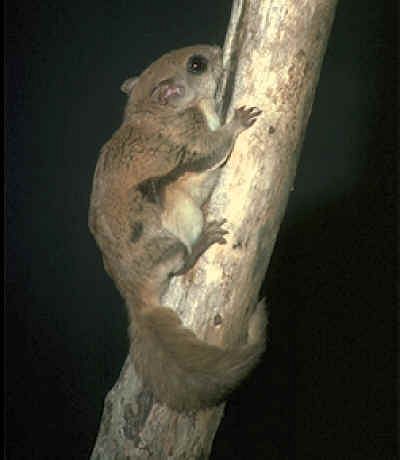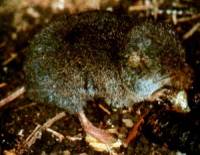|
List Of Mammals Of New England
There are 7 orders, 17 families, 40 genera, and 60 species represented among the mammals of New England. If extirpated, coastal, introduced, and accidental species are included these numbers increase to 8 orders, 26 families, 67 genera, and 105 species. The region includes the U.S. states of Maine, New Hampshire, Vermont, Massachusetts, Connecticut, and Rhode Island. The makeup and distribution of the mammals in New England are largely the result of the Last Glacial Maximum when the Laurentide Ice Sheet covered virtually the entire region. Recolonization of the area appears to have occurred from one or a few southern glacial refugia. This is in contrast to the multiple glacial refugia present throughout the American West (Stone and Cook, 2000). As a consequence of both the recent uninhabitability and the few sources of recolonization, species diversity for some taxa in parts of New England are lower than in similar areas in other parts of North America. Chipmunks and ground squi ... [...More Info...] [...Related Items...] OR: [Wikipedia] [Google] [Baidu] |
Map Of USA New England
A map is a symbolic depiction emphasizing relationships between elements of some space, such as Physical body, objects, regions, or themes. Many maps are static, fixed to paper or some other durable medium, while others are dynamic or interactive. Although most commonly used to depict geography, maps may represent any space, real or fictional, without regard to Context (language use), context or Scale (map), scale, such as in brain mapping, DNA mapping, or computer network topology mapping. The space being mapped may be two dimensional, such as the surface of the earth, three dimensional, such as the interior of the earth, or even more abstract spaces of any dimension, such as arise in modeling phenomena having many independent variables. Although the earliest maps known are of the heavens, geographic maps of territory have a very long tradition and exist from ancient times. The word "map" comes from the , wherein ''mappa'' meant 'napkin' or 'cloth' and ''mundi'' 'the world'. ... [...More Info...] [...Related Items...] OR: [Wikipedia] [Google] [Baidu] |
American Water Shrew
The American water shrew (''Sorex palustris'') or northern water shrew, is a shrew found in the nearctic faunal region located throughout the mountain ranges of the northern United States and in Canada and Alaska. The organism resides in semi-aquatic habitats, and is known for being the smallest mammalian diver. Anatomy and morphology The American water shrew is a sexually dimorphic species in which the males are generally larger and heavier than the females. The size of the shrew is and weight is . Their tail length is . The shrew exhibits a black and brown pelage which varies in shade depending on the season. When underwater, the animal appears to have a silver veneer on account of its water repellent fur trapping air bubbles. The snout features vibrissae which in the case of water shrews are specialized for aquatic hunting. Like other small mammals who spend part of their time in water, American water shrews have short hairs covering their hind limbs to bolster each paddle ... [...More Info...] [...Related Items...] OR: [Wikipedia] [Google] [Baidu] |
American Pygmy Shrew
The American pygmy shrew (''Sorex hoyi'') is a small shrew found in Northern Alaska, Canada, and the northern United States, south through the Appalachian Mountains. It was first discovered in 1831 by naturalist William Cane in Georgian Bay, Parry Sound. This animal is found in northern coniferous and deciduous In the fields of horticulture and Botany, the term ''deciduous'' () means "falling off at maturity" and "tending to fall off", in reference to trees and shrubs that seasonally shed leaves, usually in the autumn; to the shedding of petals, ... forests of North America. It is believed to be the second-smallest mammal in the world, but has an extremely large appetite for its size. Due to its fast metabolism, it needs to eat constantly. It digs through moist soils and decaying leaf litter for food. Description The American pygmy shrew is the smallest mammal native to North America and is one of the smallest mammals in the world, being just slightly larger than th ... [...More Info...] [...Related Items...] OR: [Wikipedia] [Google] [Baidu] |
Smoky Shrew
The smoky shrew (''Sorex fumeus'') is a medium-sized North American shrew found in eastern Canada and the northeastern United States and extends further south along the Appalachian Mountains The Appalachian Mountains, often called the Appalachians, (french: Appalaches), are a system of mountains in eastern to northeastern North America. The Appalachians first formed roughly 480 million years ago during the Ordovician Period. The .... Subspecies This species has two recognized subspecies: *''Sorex fumeus fumeus'' *''Sorex fumeus umbrosus'' Description The smoky shrew is active year-round. It is dull grey in colour with lighter underparts and a long tail which is brown on top and yellowish underneath. During winter, its fur is grey. Its body is about in length including a long tail and it weighs about . Habitat and ecology This animal is found near streams in cool damp deciduous and mixed woods. It makes extensive, solitary, burrows in the leaf litter on the forest ... [...More Info...] [...Related Items...] OR: [Wikipedia] [Google] [Baidu] |
Long-tailed Shrew
The long-tailed shrew or rock shrew (''Sorex dispar'') is a small shrew found in Atlantic Canada and the Northeastern United States. This shrew is slate grey in color with a pointed snout, a long tail, and lighter underparts. It is found on rocky slopes in mountainous areas along the Atlantic coast from Gaspé Peninsula, Quebec, and Cape Breton Island, Nova Scotia, to northern Georgia. It eats insects and spiders. Predators include hawks, owls, and snakes. Physical features The long-tailed shrew is small, slender, black to slate-gray in color, and with a long tail. Its average length, including tail length, is . The head and body length can be . The tail length, which averages from 80 to 90% of head-body length, ranges from . The long-tailed shrew has a hind foot length of , and can have a total body weight of . The tail is furry with hair that is faintly bicolored. In older long-tailed shrews, a loss of hair from the tail may be exhibited. The long-tailed shrew has a long, ... [...More Info...] [...Related Items...] OR: [Wikipedia] [Google] [Baidu] |
Masked Shrew
The cinereus shrew or masked shrew (''Sorex cinereus'') is a small shrew found in Alaska, Canada, and the northern United States. This is the most widely distributed shrew in North America, where it is also known as the common shrew. Description It is grey-brown in colour with a light grey underside and a pointed snout. It has a long tail that is brown on top and pale underneath with a dark tip. Its body is about in length including a long tail. It weighs about . It has darker colouring than other shrews. Masked shrews can live up to two years, but, on average, only survive eighteen months. In a long-term study done in Alaska, Yom-Tov and colleagues (2005) found that the masked shrew's body size contradicts Bergmann's Rule. The study, done on 650 specimens and spanning from 1950 to 2003, examined body size in relation to ambient temperature. Measurements of body weight and the length of the tail, ear, hind foot, and body were taken. Results yielded that the masked shrew's bo ... [...More Info...] [...Related Items...] OR: [Wikipedia] [Google] [Baidu] |
North American Least Shrew
The North American least shrew (''Cryptotis parvus'') is one of the smallest mammals, growing to be only up to 3 inches long. It has a long pointed snout and a tail never more than twice the length of its hind foot. The dense fur coat is either grayish-brown or reddish-brown with a white belly. Its fur becomes lighter in the summer and darker in the winter. Although similar in appearance to several species of rodents, all shrews are members of the order Eulipotyphla and should not be mistaken for a member of the order Rodentia. The North American least shrew's eyes are small and its ears are completely concealed within its short fur, giving it very poor eyesight and hearing. Distribution It is found from the grasslands of southern Canada through the eastern and central United States and Mexico. In Canada, only a small population of this animal has been found at Long Point in Ontario. The North American least shrew mostly dwells in mesic grasslands, marshes, and meadows. ... [...More Info...] [...Related Items...] OR: [Wikipedia] [Google] [Baidu] |
Blarina Brevicauda
The northern short-tailed shrew (''Blarina brevicauda'') is the largest shrew in the genus ''Blarina'', and occurs in the northeastern region of North America. It is a semifossorial, highly active, and voracious insectivore and is present in a variety of habitats like broadleaved and pine forests among shrubs and hedges as well as grassy river banks. It is notable in that it is one of the few venomous mammals. The specific epithet, ''brevicauda'', is a combination of the Latin ''brevis'' and ''cauda'', meaning "short tail". Taxonomy ''B. brevicauda'' is a red-toothed shrew, one of three or four species (depending on the authority) in the genus ''Blarina''. It was formerly considered to be a sister subspecies of the southern short-tailed shrew (''B. carolinensis''). The species has been divided into 11 subspecies based on morphological characteristics, which are grouped into two semispecies: ''B. b. brevicauda'' and ''B. b. talpoides''; these groupings were mirrored by a molec ... [...More Info...] [...Related Items...] OR: [Wikipedia] [Google] [Baidu] |
Northern Short-tailed Shrew
The northern short-tailed shrew (''Blarina brevicauda'') is the largest shrew in the genus ''Blarina'', and occurs in the northeastern region of North America. It is a semifossorial, highly active, and voracious insectivore and is present in a variety of habitats like broadleaved and pine forests among shrubs and hedges as well as grassy river banks. It is notable in that it is one of the few venomous mammals. The specific epithet, ''brevicauda'', is a combination of the Latin ''brevis'' and ''cauda'', meaning "short tail". Taxonomy ''B. brevicauda'' is a red-toothed shrew, one of three or four species (depending on the authority) in the genus ''Blarina''. It was formerly considered to be a sister subspecies of the southern short-tailed shrew (''B. carolinensis''). The species has been divided into 11 subspecies based on morphological characteristics, which are grouped into two semispecies: ''B. b. brevicauda'' and ''B. b. talpoides''; these groupings were mirrored by a molec ... [...More Info...] [...Related Items...] OR: [Wikipedia] [Google] [Baidu] |
Shrew
Shrews (family Soricidae) are small mole-like mammals classified in the order Eulipotyphla. True shrews are not to be confused with treeshrews, otter shrews, elephant shrews, West Indies shrews, or marsupial shrews, which belong to different families or orders. Although its external appearance is generally that of a long-nosed mouse, a shrew is not a rodent, as mice are. It is, in fact, a much closer relative of hedgehogs and moles; shrews are related to rodents only in that both belong to the Boreoeutheria magnorder. Shrews have sharp, spike-like teeth, whereas rodents have gnawing front incisor teeth. Shrews are distributed almost worldwide; among the major tropical and temperate land masses, only New Guinea, Australia, and New Zealand have no native shrews; in South America shrews appeared only relatively recently, as a result of the Great American Interchange, and are present only in the northern Andes. The shrew family has 385 known species, making it the fourth-most spec ... [...More Info...] [...Related Items...] OR: [Wikipedia] [Google] [Baidu] |



